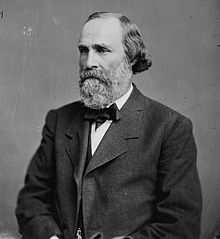 |
| Senator Henry Dawes, the author of the act bearing his name |
The Dawes Act was an attempt to assimilate Native Americans into American society. Reservations were broken up into parts that were given to the head of each family, and each individual living alone. If they behaved (to American standards), the property became theirs and they became American citizens after 25 years. Leftover land was sold to fund government efforts to "civilize" the natives. The "Five Civilized Tribes" - the Cherokees, Creeks, Choctaws, Chickasaws, and Seminoles - were exempt from the act.
 |
| A depiction of "forty acres and a mule" |
This act is similar to the "forty acres and a mule" that were given to newly freed black people after the Civil War. Like the Dawes Act, the federal government gave a marginalized group of people a plot of land to allow them to become a part of American society. Also, both efforts failed, as the land given in the Dawes Act was unsuitable for farming, and turned out to be too small, and President Andrew Johnson ended the forty acres policy, and many blacks had their land taken away as Johnson redistributed the land to whites.


No comments:
Post a Comment